Stay powered wherever you go with the Jackery Explorer 1000 V2. Featuring a high-performance 1 070 Wh LiFePO4 battery and advanced ChargeShield 2.0 technology, this solar generator charges from 0 – 100% in just 1 hour (emergency mode) and maintains over 70% capacity after 4 000+ cycles for a 10+ year lifespan.
- High Output: 1 500 W continuous AC (3 000 W surge) to run mini-fridges, electric grills, CPAP machines and more.
- Rapid Recharge: 0 – 100% in 1 hr via AC input with emergency mode; 1.7 hrs in standard mode to prolong battery life.
- Multiple Ports: 3× pure sine wave AC outlets, 2× 100 W USB-C PD ports, 1× USB-A port, 1× 12 V car port, plus built-in LED light.
- Lightweight Design: Only 10.8 kg (23.8 lbs) with a foldable handle—perfect for camping, RV trips & off-grid living.
- Smart App Control: Adjust modes, monitor status & enable 1-hr charging via the free Jackery App (iOS & Android).
| Battery Capacity | 1 070 Wh |
|---|---|
| Battery Type | LiFePO4 |
| AC Output | 1 500 W (3 000 W Surge) |
| USB-C Output | 2 × 100 W PD |
| USB-A Output | 5 V/2.4 A |
| Car Port | 12 V/10 A |
| Connector Types | USB-C, USB-A |
| Voltage | 120 V AC |
| Weight | 10.8 kg (23.8 lbs) |
| Charge Cycles | ≥ 4 000 to 70% capacity |









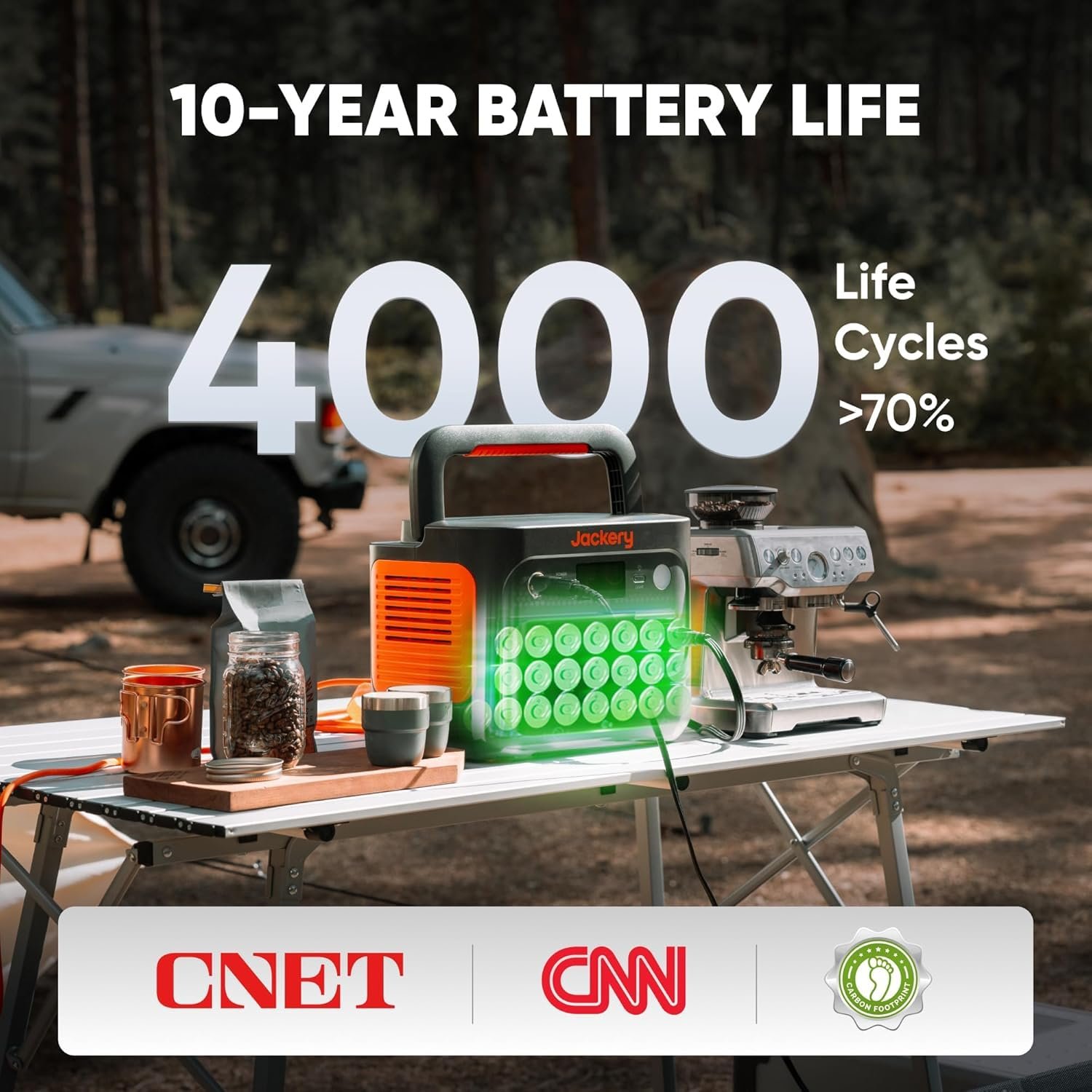














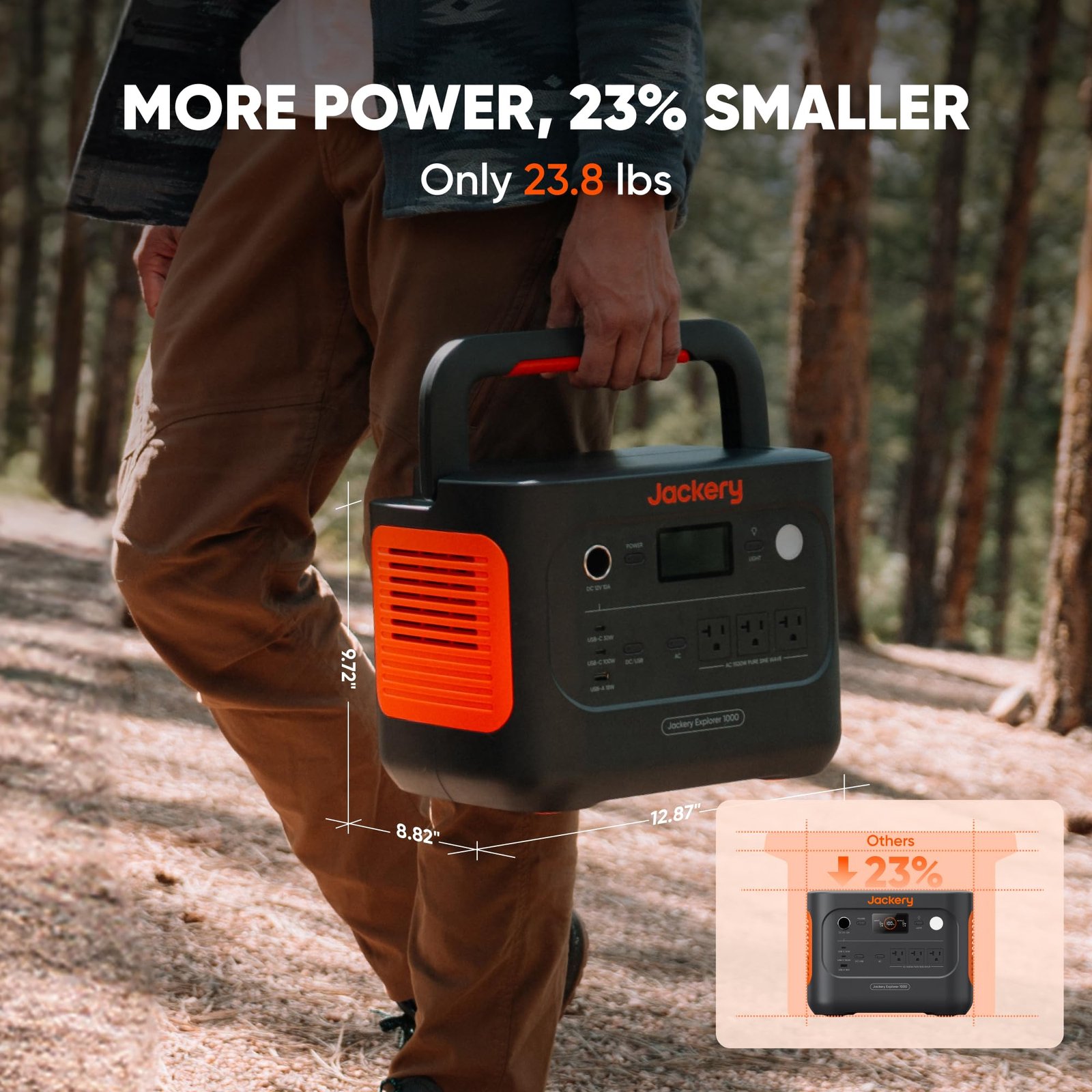





























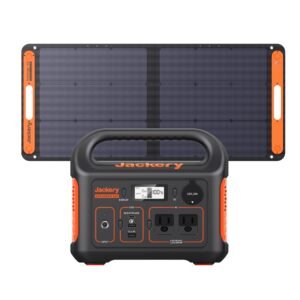


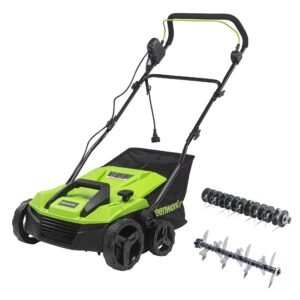

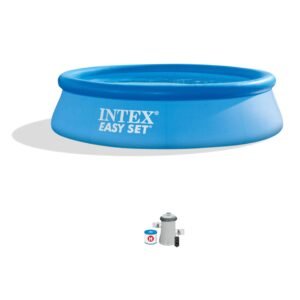



I kept track of our sales in a notebook.
For the past several years, I have used a laptop to record our sales, and now I use an iPad. With both, I had a problem keeping the laptop and then the iPad charged.
Our Farmer’s Market lasts for four hours on Saturdays, and I use the E300 to power my iPad, a Square card reader, a video camera, and calculator.
Instead of worrying about loss of power, at the end of the Market Day, my Jackery E300 still has 84 to 87% of power left.
Buying the E300 solved that problem so well, I bought another E300 in case of a power outage at home.
The instructions are in Chinese English and not much help. Also, I have NO idea why it's marketed as a "solar generator". It is NOT a generator and doesn't have ANY solar capabilities other than you can connect a solar panel to it to charge it. It's a portable DC power pack with a built-in inverter to also provide 120V AC current via normal household plugs, in addition to 3 DC USB outlets and a DC car plug.
I read the instructions and here's some initial observations and contradictions of what I saw advertised above:
-- This Power Station is 300 watts (which is fine for my application). I've seen several reviews stating that this is 'junk' because it won't power their tea kettle, induction burner, hair dryer, portable heater. Most (if not all) of those are over 300 watts, so the Power Station will shut off and not power those devices.
-- The instructions also state that the power station will go into battery save mode and turn off if it detects less than 10 watts for a certain period of time.
-- Each output power option (USB, AC, Car) has a power button with a light on it. If it's turned on and you are not using it, it will drain the battery faster. So when storing, make sure those are turned off. I think the battery will still drain but at a slower pace, as the instructions say to charge the battery every 90 days when not in use.
-- There is conflicting information about the description of the item and one of the photos. Yes, you are able to charge the battery and use the power station at the same time. The instructions, though, state that this is not recommended as it will decrease the health of the battery. I saw a picture above with the solar panel and charging a laptop and cell phone at the same time. According to the instructions, this is not recommended.
-- I saw the newer update of this power station. I opted to get this one because extended warranties have come in handy in my household. The newer model has a 1-year extended warranty and I can get a 4-year extended warranty with this one. I didn't know at the time that the instructions state that it has a 2-3 year warranty. I am not sure which one, because one page states that the power station has a 2 year warranty. On another page, it states in order to get warranty service, I need to register the product. After I register, it states that i get 'the full 36 month warranty'.
I will update this review once I've had the power station for a few months and will report on whether I've had issues with the battery draining too fast, or other things that have been mentioned.
Attached are a few photos of my food warmer set up under my took cart. A photo of my job site so you have an idea of how much distance I have to go without power and how much of a life saver this is. And some voltage readings. The volt reading is well withing range for 120v electronic. I had an inverter recently that I my have me 120v. Your house sockets normally I my gets you 116 give or take 1 or 2 volts.
Back in April, I purchased the Jackery Explorer 1000 and the Goal Zero Yeti 500x later as a result of 2019's fires. Coincidentally, this year's fires on the entire US west coast is actually WORSE with new records broken! I cannot stress how important it is to be prepared for emergencies, and with a baby and young boy in our household, I wanted to ensure we have a crucial refrigerator running to store milk, medication, and whatever else we needed.
There has been an increase in people taking emergency preparation more seriously.
I had since invested in several car freezers (favorite is the Foho 34qt BCD-32) as part of my emergency toolset. When Jackery announced the Explorer 300 (E300) with a special launch price and some improvements over the Explorer 1000 (E1000), I jumped on it for one simple reason: my little boy loves camping, and I wanted him to have a mini-Explorer of his own (actually, I wanted another backup battery, but don't tell him that.) Literally, the E300 is a mini version of the E1000, and it looks awfully cute to have my son and I stand next to one another holding our own Explorers!
Right off the bat, the two models are very similar to one another, and so I will be re-using much of what I had already written for the Explorer 1000. The E300 is the direct successor to the company's Explorer 240 model.
CELL MANUFACTURERS
Today's devices use Lithium-ion (Li-ion) and Lithium Iron Phosphate (LiFePO4) cells so they can pack more power in a smaller package and weigh less. However, Li-ion (which the Jackery is made with) also is more volatile whose risk increases as more cells are packed together. The quality of the battery cells and the BMS (Battery Management System) are crucial for safety.
- Battery storage capacity is measured in Wh, and power output is in W (Watts)
- The higher the Watt-hour (Wh) capacity rating, the more dangerous the battery could become if not handled right
Battery cells made by LG and Sony are among the best in the hobbyist world as are Sanyo/Panasonic, Samsung, and BAK Battery. Jackery Explorer 1000's batteries are made by LG and BAK, but the E300's are by EVE Battery. I do not have much information about the new, publicly-traded manufacturer's safety record, however, but going by Jackery's track record, they likely would not have selected a poor company to provide fuel cells for their power stations.
During my years of research, I found that use of lower-quality batteries could pose a serious risk to life and property and should become a crucial part in deciding what to buy.
IN A NUTSHELL
Jackery Explorer 300 is a relatively light power station with a professional-looking exterior and flashy, orange color scheme, and is backed by a company that appears, from the stories I have read (and personally experienced), to take customer service seriously. The batteries are made by a manufacturer I do not know much about, but their weight is an indicator that they are likely good quality. The 300W of energy (and peak of 500W) provides enough power for a small amount of electronics and small appliances, such as a laptop, television, mini fridge, medical device (like CPAP), and car freezers, but will NOT work for most rice cookers, and definitely not for a vacuum, water boiler, or circular saw.
Like the bigger E1000, the hard, plastic material used to help shed weight (and cost) could be prone to cracking from hard falls or bumps, potentially exposing the Lithium-Ion batteries to puncturing. The fixed carry handle unfortunately cannot be folded, making it not ideal for packing things on top.
Functionally, this is an excellent, portable power station with a multitude of AC and DC outputs, is solar charging capable with MPPT built in, and has a battery management system (BMS) to help ensure safety. Equally important is its verified claim of a pure sine wave - not modified - AC Inverter to produce clean electricity for sensitive electronics. Like Goal Zero Yeti 500x, Jackery finally upgraded the E300 with a USB-C PD with a 60W output. The E1000 only produces 18W. This makes it very useful for charging supported laptops.
Jackery is one of Amazon's top sellers in the portable power station category with good customer service and reasonable prices, and as this is no longer my first experience with their products, I have no hesitation to recommend its latest product.
PROS
- At 293 Wh capacity, it is an improvement over its Explorer 240 model and falls in-between Goal Zero's Yeti 200x and 500x capacities
-- Capacity to power a 30" LCD monitor and Mini PC for 3-5 hours, a Toshiba 50" Fire TV for almost 2.5 hours
- Pure Sine Wave AC Inverter capable of continuous 300W power (and 500W peak) - More details later
- Very well-priced at $349 at launch
- Can power AC and DC (USB/12V Car adapter) at the same time (as long as they draw less than 300W combined)
-- Laptop, tablet, phones, lights, fans, CPAP medical device, projector, TV, mini refrigerator, speaker, camera, DSLR battery charger, and SOME rice cookers
- USB-C PD port outputs 60W
- Can be used while charging
- Faster charging with MPPT controller (Maximum Power Point Tracking)
- Informative LCD with LED backlight
-- Total power coming in (via solar panel or AC adapter)
-- Capacity left (as a percentage)
-- Total power (AC and DC combined) being used
--- Suaoki G500 displays the Wattage separately for DC and AC, which I prefer
-- Unfortunately, estimated hours to full charge or empty is NOT shown
- BMS provides built-in overload, overcharge (automatically stops charging when the device is full), and short-circuit protection
-- Multiple fans to keep the station's temperature safe
- VERY compact at 9.1" x 5.2" x 7.8", though the higher-capacity, slightly larger Goal Zero Yeti 500x is still my favorite for its size and capacity
- Portable at just 7.1 lbs
- Bottom is well-protected by bright-orange, non-slip feet
- Carry pouch included to hold AC charger and cables
- Cigarette socket cable included
- Unexpectedly good customer service
-- Technical support was excellent in answering all my questions
- 2 year warranty
- Clear, well-written manual, though details were scarce
-- Goal Zero's manual, on the other hand, is VERY detailed and helpful
- Company is based in California
CONS
The E300 shares almost all the same design problems I disliked about the E1000, but also adds some improvements.
- Batteries are not made by a globally well-known, Tier 1 manufacturer
-- My unit came with fuel cells by EVE Battery, a China-based, publicly-traded company
- No Anderson input port for solar charging
-- You charge with an (optional) Anderson-to-8mm converter cable instead
- Fixed carry handle cannot be stowed away
-- Makes it difficult to stow things on top at the back of a trunk
-- Upward-curved top (underneath the carry handle) does not allow small items to be temporarily stored on top
- Hard, plastic material makes the power station lighter, but could be prone to cracking from hard falls or bumps
-- Given that Lithium-Ion batteries become more volatile as capacity increases, one should handle the product with care
- Although the exterior looks very professional, once I saw the Goal Zero Yeti 500x, I fell in love with the Yeti's design
- Power buttons can be accidentally turned on/off through a single press (ie. while packing away your camping gear)
-- Can lead to accidentally turning on/off the output during transport
-- May unexpectedly find battery fully drained when you need it
-- Suaoki requires you to hold the DC or AC button for 2 seconds before it turns on/off that output, helping to minimize accidental presses
-- No automatic power off once no power is drawn/station has become idle
- AC power brick is flat and large
- No built-in flashlight or SOS signaling that the E1000 includes
- Display is not as informative as I'd like
-- Only shows battery charge level, input and output wattage, but no estimate of time remaining to full charge or to empty
- Multiple fans turn on during high peak and can be too noisy for some
- Battery cannot be replaced. This can lead to unnecessary landfill waste
- Cannot be daisy-chained to other Explorer 300/1000's to extend battery capacity
-- Some Goal Zero stations can be hooked up to other ones so power can be provided for an even longer time without needing to switch
- Not waterproof. Keep it away from water splashes, rain, and pool!
-- Lithium and fire or water can cause serious damage or injury!
- No master power off button to turn off ALL outputs at the same time
-- You have to manually switch off each type: DC, AC
- No carry bag for the power station itself is included
-- BUILT Willis 11" Insulated Lunch Box (ASIN: B08D6VMGG1) fits the E300 perfectly well (with usable pockets) when the Jackery is put on its side
INPUT PORTS
- 1x 8mm
-- Accepts up to 90W
-- Max 12-30V and 8A with no minimum wattage
--- WARNING: Do NOT use a power source/solar panel that exceeds 30V or 8A!
---- Be mindful that solar panels that are daisy chained in sequence/series may output more than 30V combined!
-- Can be used for solar charging
--- MPPT charge controller is built in
--- I recommend using a panel that's between 30W – 100W at 18V (with the right Amps to equal 100W)
---- If you attach a 120W solar panel (with 12V x 10A = 120W), it will charge at only 90W
--- I did not test solar charging as California is currently blanketed by smoke from the massive fires all over the west coast
--- Jackery SolarSaga 100W charged the Explorer 1000 at an excellent 69-88W of input. I expect it to be similar with the E300
OUTPUT PORTS
- 2x AC with 3 prongs (120V)
-- Inverter can handle a continuous 300W, peaking at 500W. More on that later
-- Pure Sine Wave Inverter
--- Ensures clean power to protect against damage to sensitive electronics
--- Generates less heat
--- Note: Some manufacturers claim to be Pure-Sine when they are actually Modified or Square Waves
- 1x Cigarette socket (12V, max 10A)
- 1x USB-C PD (5-20V, max 3A, max PD 60W)
-- PD (Power Delivery) allows a device to be charged with up to 60W through the USB-C interface
- 2x USB-A (5V, max 2.4A, max 12W)
-- One of them is a QuickCharge 3.0 for rapid charging of compatible devices
USAGE
- To turn ON or OFF the Car/USB (DC) or AC outputs, press the corresponding button
-- Note: This single-press (without hold) can lead to accidentally turning on or off the power station
- To reset an Error condition that's shown on the LCD (ie. AC port is Overloaded), turn OFF the respective AC or DC output, and back on
- To reset the Explorer, hold the DISPLAY button for 10 seconds
- Li-ion batteries have 500 charge cycles before capacity drops to about 80% from when they were new
-- Product could, in theory, be charged up to 2,000 cycles — about 1/4 of total capacity is lost every 500 cycle
- Unlike LiFePO4 batteries, Li-ion can operate only in temperatures between 32-104F (0-40C)
-- Jackery's Battery Management System (BMS) prevents:
--- Recharging in temps outside of 32 - 95F (0 - 35C)
--- Outputting power in temps outside of 14 - 104F (-10 - 40C)
- Battery, like all Li-ion, slowly drains over time even when station is powered off
-- Could take 1-1.5 years to go from full to empty
CONTINUOUS VS PEAK OUTPUT
The Explorer's AC Inverter provides a continuous output of 300W with a peak/surge of 500W
- AC Inverter: Component responsible for converting battery (DC) power into AC for use by electronics
- Continuous Output: As long as a device (or combination of multiple ones) does not exceed 300W, it can be used
-- Example: A TV that uses 100W can be used because it is less than 300W. You can add more devices as long as they do not exceed 300W combined
-- Example: A miter saw I have uses 1,800W, and because it exceeds 300W, it cannot be used
- Peak/Surge: Almost every device temporarily draws more power when it is turned on. The highest amount it pulls during that time is the Peak/Surge. This Explorer can accept up to 500W
-- Example: A TV that uses 200W (continuous) may temporarily suck up 400W (peak) when powered on. Because 400W is less than 500W (peak), this battery will allow the TV to turn on at that level for a few seconds (any longer, and it might cut power as a safety precaution). After a few seconds, the TV then only uses 200W (less than the continuous 300W limit) until the battery is drained
-- Example: An unusual device that uses 250W (continuous) and surges to 1,500W when powered on would instantly be shut off by the Jackery. Why? Even though the device uses just 250W while already on, it jumps to 1,500W when powered on, exceeding the 500W surge limit of the Jackery
CALCULATIONS
The below calculations are rough estimates as conditions, quality, and product age can vary.
CHARGING TIMES
- Wall charger: 4-5 hours
-- AC adapter was observed to provide 76W when charging level was at 37%
-- AC adapter will gradually charge slower as battery reaches full capacity (for safety reasons)
- 100W solar panel: depending on weather conditions, it should take about 5-6 hours. I could not fully test this because the smoke from the California fires is blocking the sun
-- WARNING: do NOT connect panels sequentially or you may output too much voltage and fry the power station! Connect them in PARALLEL with a Y-Branch cable
- Goal Zero Yeti 500x can combine its 8mm and USB-C PD ports for a total input of 180W. Neither the E300 nor E1000 can combine both inputs
HOW MANY WATTS DOES A DEVICE US?
- Calc: Watts used by device = Voltage x Amperage
- If a vacuum is 120V and 9.5A, it uses 1,140W
If a device draws more than 300W for an extended period of time, the power station will shut off as a safety precaution. This can also shorten the battery's lifetime
HOW LONG CAN A DEVICE BE USED FOR?
- Calc: Hours available for device = Battery capacity (Wh) x 0.85 / Watts used by device
-- Generally, about 10-15% of power is lost during power conversion
- If a device uses 60W, it could last up to 4.1 hours (293 Wh x 0.85 / 60W)
- Amazon TV I have uses about 100W
-- If battery is full at 293 Wh, TV could run about 2.6 hours (293 x 0.9 / 100)
HOW LONG DOES IT TAKE TO CHARGE A DEVICE?
- Calc: Hours to charge device = Device's battery capacity (Wh) / Input Wattage
- If a laptop accepts 60W of input and its battery capacity is 200 Wh, it could take 3.3 hrs to charge (200 Wh / 60W)
HOW LONG DOES IT TAKE TO CHARGE THE EXPLORER 300 WITH SOLAR?
- Calc: Hours to charge battery = Battery capacity (Wh) / (Panel Wattage x [0.5 or 0.75])
-- In a perfect lab environment, solar panels charge at the indicated wattage (ie. 150W)
-- Expect to only receive 50-75% on a good, sunny day (ie. 75W - 113W), depending on environmental conditions, panel's age, and component quality
-- Tip: Even if it is overcast, the panels will STILL collect solar energy. Keep charging!
- If a solar panel is rated for 100W, it could take as fast as 3.9 hours [293 Wh / (100W x 0.75)] to charge
HOW DOES ITS CAPACITY COMPARE TO POWER BANKS?
- Calc: Powerbank-equivalent capacity (mAh) = Battery capacity (Wh) / Voltage x 1000
-- 1 Ah = 1000 mAh
- Explorer's 293Wh at 3.6V is roughly a 81,389 mAh powerbank (293 Wh / 3.6V x 1000) or a 27,129 mAh at 10.8V
TIPS
- Always test your devices with the power station before you depend on it on the go
- Lithium-ion batteries are volatile
-- To minimize fire damage to your belongings or loved ones, store the power station in the garage and not inside the house. Best storage is a dry, cool place, however
-- You cannot bring a battery of this capacity on a plane
- With the right BMS, quality batteries, and other factors, the power station can be stored in the car while camping during a hot, California summer
-- Keep the battery out of direct sunlight. I usually store it on the floor of the car and crack open the windows a tiny bit
-- Do not USE in the car if temperatures fall below or exceed the battery's rated, operating temperature (32-104F or 0-40C)
Keep your car cigarette lighter with the power station -- you could plug it into its 12V DC socket for starting a camp fire
- If using a car charger, make SURE you only charge this station while the car is RUNNING. Otherwise, you'll deplete your car's battery and leave you stranded
- If charging with a solar panel, be sure to keep the station out of direct sunlight as it could overheat
-- A solar panel is NOT required to use the battery
-- Explorer 300 uses the MPPT solar charge controller
--- Smarter, more efficient/expensive than PWM
--- Suitable for larger systems
- Can be used and charged at the same time. Manufacturers’ recommendations for their own products:
-- Yes, that’s fine: Goal Zero, Jackery, Rockpals, nrgGo
-- No/Not advisable: Suaoki
- NEVER charge the power station itself in below freezing temperatures, or you will damage the Li-ion battery AND potentially limit its overall capacity
-- You CAN use it to power OTHER devices because the generated heat will warm its battery enough to be within operating temps
-- At below freezing temps, keep it in an insulated cooler and connected to a power source (ie. solar panels). The heat generated by the battery will keep it running as best as it can
- Turn off any output ports (AC/DC) that are not being used in order to conserve power
- Do not use any power station in a tightly enclosed area as it can overheat
- To prolong the battery lifetime while in storage, keep the battery fully charged every 3-6 months
-- Or, according to customer support, keep it plugged in when not in use and discharge it to 50% every 3-4 months
-- NOT using the battery for a very long time can actually hurt its lifetime
-- There is no "memory effect" in this station's battery. It is better to NOT let it completely drain
FINAL THOUGHTS
The Explorer 300 is another winner for Jackery in that it has made several improvements over its older, bigger brother, the Explorer 1000. I was disappointed to find out that its batteries are made by EVE Battery, a Chinese, publicly-traded company I have little knowledge of. The Explorer 1000, on the other hand, used either LG or China-based BAK Battery, both of which are excellent manufacturers. The company has shown time and time again that it takes customer service VERY seriously, and to me, that is a major plus. The 300W of energy (and peak of 500W) provides enough power for a small amount of electronics and small appliances, and is the perfect size for my little boy, the fellow explorer and camper.
The hard, plastic material commonly used by power stations to help shed weight and cost (just like the E1000) could be prone to cracking from hard falls or bumps, and as such, this product should be handled with care - a puncture of the Lithium-Ion batteries could cause severe harm. The fixed carry handle unfortunately cannot be folded, making it more difficult to pack things on top.
Jackery is one of Amazon's top sellers in the portable power station category with good customer service and reasonable prices, and if the new EVE Battery manufacturer proves to be as reliable as other Tier 1 makers, I will have no hesitation to recommend its latest product.
UPDATES:
9-17-2020
1). From 99%, it took only 10 to 15 minutes more to get to 100% when plugged into the 12V DC outlet of my vehicle & the Explorer 1000. More efficient charging than through my gas generator’s AC outlet. Pleasant surprise!
The GREATS
1). Faster 12V DC Charging
Immediately after picking it up from the post office, I took it out of the box & plugged it into my vehicle’s 12V DC outlet & charged it during my 4 to 5 hour trip back up the mountains where I’ve been staying since the pandemic. It was at 37% charge capacity when it started charging. After approximately 3 hours and an input of steady 80 watt, it was at 99% charge already(to my pleasant surprise). This is a huge improvement to the Explorer 240 because it would take about 5 hours to get recharged the same capacity. In addition, this is very important to me since I don’t have my solar panel yet and I do a lot of driving exploring a huge forest.
2). Improved 12V DC Cable
This was my initial BIG complaint when I got my first Jackery, the Explorer 1000. I didn’t get one in my box. Even worse, when I borrowed my friend’s 12V DC cable charger (cause it took a while to get one from Jackery), the PLASTIC TIP that inserts into my vehicle’s 12V DC outlet melted (see photo) after charging the Explorer 1000 through the same 4 to 5 hour trip back up the mountains. I did not experience this problem with the Explorer 300. Although the cable seem the same, the plastic tip DID NOT MELT this time. Imagine my relief.
3). 293WH Seemed More Efficient
As soon as we got back to our campsite, I immediately unplugged my 70qt car fridge/freezer from the Explorer 1000 & plugged it into the Explorer 300’s 12V DC outlet. I left the Explorer 300 with 99% charge while the fridge was set at 20°F on eco mode (as always). When I checked it in the morning, it was at 50% charge after 9 hours overnight. Usually, the Explorer 240 would be down to 40% or 30% charge and the Explorer 1000 would be down to 60% charge from 100% at the same settings. However, I also have to mention that the first night that I got and used the Explorer 300 was also the first night that the temperature was very cold at 24°F. It most likely helped run the fridge’s compressor less frequent which meant less power demand. I’d know for sure next summer and I’ll give an update here.
4). Recharges My USB Devices Pretty Fast
Although I don’t have a definitive and scientific measurement of how long it takes to recharge my devices: cell phone, tablets and Jackery power banks, I know for sure that the recharge time is appreciatively faster than when I’m using the Explorer 240 to do the same task. Ergo more productivity.
5). Consistent Charging With a Gas Operated Generator
The input was a steady 77 watt from a 120 volt AC outlet of my generator which I prefer to the fluctuating input of 162w to 167w into the Explorer 1000. It’s really no big deal, but I just like it better steady.
6). Plenty of Safety Features
a). Like the other Explorers, the Explorer 300 also shuts down after 12 hours if a plugged device(s) drawing under 10 watts of power. This happened to me when I plugged my 12V electric fan into the 12V DC outlet drawing only 7 watts of energy. According to Jackery, this is to prevent damage to the lithium ion battery used in the unit. In turn, this feature also helps the unit last longer.
b). Like the Explorer 240, the Explorer 300 does not power or run my 12v DC tire inflator/compressor at high state of charge. During my test, the Explorer 300 was at 86% charge capacity. Even after three times of attempt to power my tire inflator, I had no luck. However, I was able to run the inflator when the Explorer 300 was down to 45% charge. Again, according to Jackery, this is a safety feature.
c). Unlike the Explorer 240 that doesn’t have one, the Explorer 300’s 12v outlet’s rubber cover certainly prevents foreign objects from being inserted. Thus, avoiding electrical accidents or fire.
d). The unit’s design is very safe for children & pets. There are no moving parts or handle that folds down to trap any body part. Moreover, there’s really no paint to chip and swallow. The paint seems to be baked in. There’s also no sharp corners!
The SHORTS
1). Takes a Long Time to Charge to 100%
Although it’s quick to get to 99%, it took almost an hour to get the last 1% of charge via the 120v AC outlet of my gas operated generator because the input goes down (see photos) as the charge goes up. Bummer!
2). Won’t Run My 12V Tire Inflator at High Charge Capacity
It just doesn’t make sense to an electrically challenged person like me why I can’t power my inflator while the charge capacity of the Explorer 300 is above 50%. This means that if I had a flat tire or I need to inflate my air mattress & rubber boat (at the lake, away from my vehicle’s 12V DC outlet) I have to deplete the charge capacity to 50% or less first from a full charge or never fully charge it.
In the end, the Explorer 300 embodies the same high quality that is a signature of Jackery. Kudos to the Jackery team for producing another top shelf unit that is of great value. I highly recommend this product to everyone. This is especially helpful during this present time of uncertainty.
Hope this helps.
The Jackery Explorer 300. What is it? Some know it as a power station, some know it as a solar generator, and some have no idea nor clue as to what the unit is or how to even utilize it. This review should shed some light on that and get you folks up to speed and in the know in regards to what there is to know about this new Jackery Explorer 300 power station / solar generator.
Portable power generation and storage. The new Jackery Explorer 300 released on September 1st, 2020 of this year is Jackery’s latest and greatest product to hit the off-grid power sector. Their products are used by campers, nomads, tailgaters, and preppers alike. The Jackery power stations are portable power solutions that can be powered or recharged via solar power, automotive 12v DC, AC 110v home / office outlet, or shore power connection from an available external power source at a camp site / RV Park.
Jackery Explorer 300 features the latest and greatest in tech with it’s modern USB-C PD output port, USB-A QC 3.0 output port, addition of a second 110v AC receptacle, and an all new MPPT charge controller built-in to the unit to allow for rapid and sustained high-speed charging, doubling that of the previous Jackery Explorer 160 and Explorer 240 models on the market. Weighing in at only 7lbs, this new Explorer 300 model is the pinnacle of lightweight and portable power! Paired with a Jackery Solar Saga 60 solar panel and you would be sustainable with unlimited green power whilst backpacking / hiking out in the wilderness for days on end.
Power Stations / Solar Generators like the Jackery line of products, specifically the Explorer 300 are perfect for van life nomads like myself whom are not into complicated DIY custom built setups and just want the convenience and robust nature of a simple all in one power station with built in I/O ports that the Jackery Explorer 300 offers. This solution is for the “grab and go” lifestyle and requires no thought or setup whatsoever as the Jackery Explorer 300 is dummy-proof in regards to deployment and using out in the field or in your vehicle.
The industry leading two years manufacturing warranty gives you a peace of mind knowing that Jackery stands behind their products and has you covered in the event you run into any issues. Jackery is based out of California, USA and has an award winning customer support staff on their team to answer any questions or provide you with any product support you may need. All of my interactions with Jackery customer service has been nothing but positive since day one as I am a longtime customer of theirs since 2019, purchasing and owning of their Explorer 500 power station and as well as their Solar Saga 60 solar panel. In fact, I own two of their Explorer 500 power stations, but that’s neither here nor there.
Devices I plan to power or recharge with this specific unit include, but are not limited to; iPhone XR, PlayStation Vita Slim, Nintendo Switch Hybrid v1.0, Razer Blade Stealth 13 | Late 2019 Ultrabook, Insignia 19” 720p TV, Opolar 9” rechargeable fan, Aukey touch lamp, Goal Zero Crush Lantern, HotLogic Mini 110v oven, Alpicool C15 12v compressor refrigerator.
Included in the package:
(1) Jackery Explorer 300 Power Station
(1) Soft zippered pouch to store power cables
(1) 110v AC wall / shore power adaptor
(1) 12v DC automotive power cable
(1) 2 year warranty miniature Jackery card
(1) User Manual / Quick-Start Guide
(1) Jackery product satisfaction tree flyer
Pros:
-Lightweight portable power solution at only 7lbs!
-USB-C PD output port at 60 Watts!
-USB-A QC 3.0 output port.
-DC 12v output is regulated at 13.3v
-Upgraded beefy 12v DC to 8mm power cable.
-300 Watt / 500 Watt Peak Pure Sine Wave inverter with two receptacles instead of one.
-MPPT charge controller built-in vs the PWM charge controller on Jackery’s older units as well as much cheaper power stations on the market. MPPT allows for significantly faster recharge times.
-Pass-Thru charging! The Jackery Explorer 300 can be recharged and discharged at the same time. Collecting solar power (solar panel sold separately) and using it to your hearts content!
-Robust backlit LCD that contains all pertinent data user may need to know in regards to device power usages, input, output, and operation. Included battery percentage, battery segment visual graph, as well as input and output wattages.
-High / Low temperature alarm indicators.
-Auto-Power off if left running for 12 hours without a significant load exceeding 10 Watts applied to the power station. This will save battery life and cycles.
-Low Battery Warning. LCD screen will flash ten times at 20% and 10% power remaining to signal to user that the power station needs to be recharged.
-Warranty! Industry leading 2 years manufacturing warranty with ability to extend 12 additional months via registering your product purchase on Jackery’s website!
-Lifetime Technical Support! Have any questions? Contact Jackery Customer Service Department. They are headquartered out of the United States in the State of California and they will get you taken care of.
Cons:
-No wide area light / lantern included on the back of the unit like some other power stations on the market in this class include.
-USB-C PD port is output only. Does not accept input for charging.
-No USB-C to USB-C cable included with the package
-DC 12v Automotive Port is only rated at 10A, and is unable to power a Slime 12v automotive tire air compressor.
Final thoughts:
The Jackery Explorer 300 is a robust piece of kit to own for your camper van / RV, vehicle of choice for tailgating, carry in your backpack for hiking, or store on a shelf at home for emergency preparedness in a grid down scenario. Despite the few shortcomings of the unit that could be addressed by Jackery in future revisions of their power stations, the advantages this lightweight and compact power station offers make it completely a worthwhile investment and I am quite happy with my purchase! I plan to use the Explorer 300 in my 2017 Ram ProMaster City camper van on a daily basis in conjunction with my Jackery Explorer 500 and my Jackery Solar Saga 60 solar panel. I hope to purchase a Jackery Solar Saga 100 solar panel one of these days to perform additional testing with the Explorer 300. I rate the Jackery Explorer 300 a 4.5 / 5 Stars (9/10) rating here on Amazon and I highly recommend purchase of this product should you find yourself wanting or needing off-grid power for whatever reasons you may have. You will not be disappointed. Jackery will guarantee it.
I have tested the E300 with several LED & CFL lights that can be used in table lamps and the best one is a 14W Grt Val 1500 Lum LED 'DayLight' bulb, It draws 20 Watts and the E300 will power it for 12-14 Hours from 100% to 10% battery charge levels. The fan will run part time and is very quite. I place the LED light bulb in a small table lamp and it can be moved as needed. You probably already have LED's in your table lights so just use one of them. I also tested a Philips 11 Watt 1000 Lumens LED light for 6 Hours and the E300 charge level decreased from 90% to 60%. I also tested a 5 Watt Onite 400 Lumens USB LED light for 9 Hours and the charge only changed from 90% to 75%. Any of these three choices are a big improvement over my LED lanterns that start out bright but quickly dim unless you run them on low power. As a result of purchasing the E300 I have retired several of my D-Cell LED lanterns that were being used for the power outages and replaced them with table lamps, rechargeable LED Lights and flashlights with rechargeable AA & AAA batteries.
I have a UPS to protect my desktop computer that gives me 20 minutes of runtime in a blackout but if I plug the UPS with the connected computer into my E300 I can extend the operating time at least two more hours. My internet also provides my telephone service and the U-Verse modem needs power or I lose telephone service. The Power Lift Chair can operate from the E300. The "Merlin@Home" Transmitter needs power to send pacemaker data and worked just fine when tested.
I like having more than one power station because I won't need extension cords for each device that I want to power and that also lets me place then in different parts of the house. The E300 has some new features that were not on the E240. The AC Inverter is now 300 Watts (pure sine wave), the 13.3 Volt regulated car port output has a nice cover and the USB output has 60W PD USB-C, QC3.0 USB-A, USB type A port (2.4A). The MPPT charger provides faster charge rates from solar (5.5H), AC (4.5H) and from a car port (5H).
An important feature of the Jackery Explorer 300 is the pass through charging can be used to supply power continuously to a critical load by charging the E300 from the DC Carport on another Jackery Explorer. If the load on the E300 is 75 Watts or less the E300 will stay almost fully charged. The Jackery (E1000, E500, E440, HLS290, E240 or E160) can supply power until their battery is exhausted. This method will allow you to keep the E300 in a critical place without the need to move it outside to recharge by a Solar Panel or Generator. The other Jackery Explorer unit can then be moved and recharged as needed. The DC charging cable you will need is supplied with the Jackery Explorer 300.
The E300 is much more useful than just for power outages and I am discovering more uses every day. The E300 provided power when the wife needed a heating pad while setting in a wheel chair a few days ago. I have a solid state Oscilloscope that the Jackery E300 can power for several hours and that makes one of my best pieces of test equipment truly portable. The E160 and the E300 are used to provide power for my Ham Radio equipment when operating at temporary locations.
Two things that would help with my Ham Radio Equipment is the addition of Anderson PowerPole connectors on the DC input and DC output. This would help when charging the E300 and powering my radio equipment from the E300. The ability to turn off the "Auto-power off feature when the draw is under 10 watts" would really be handy. This feature is great for saving the battery but not so good when powering tranceivers that are monitoring an emergency radio frequency. You just might miss your call.
For maximum battery power, charge Lithium-ion Batteries every 6 months to compensate for the self discharge and for longer life, charge before going below the 20% charge level.
The Jackery Explorer 300 is well worth the price and is expected to provide excellent service for many years.
Here are some photos of just a few of the items that the E300 can power.
Jackery Explorer 300 Waveform; Heating Pad on Wheelchair; AA & AAA Battery Chargers; Rechargeable lights; Ham Radio Equipment; Jackery Explorer 300 with accessories; AC, DC & USB fans; Solar Charging in Morning Sun; Power lift Chair; Oscilloscope; AC, DC & USB Powered Lights